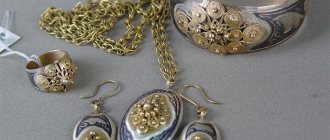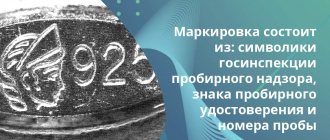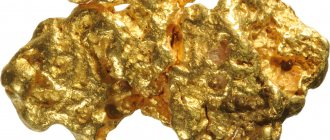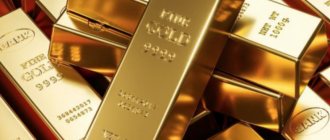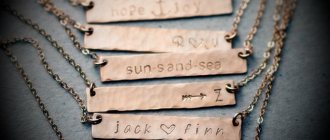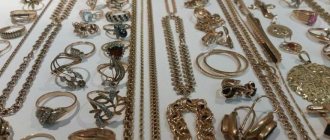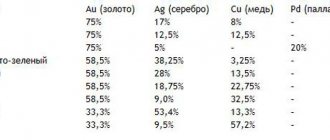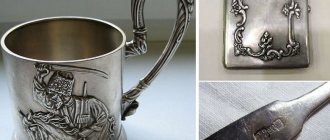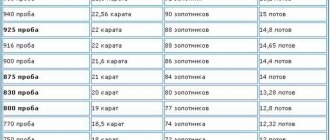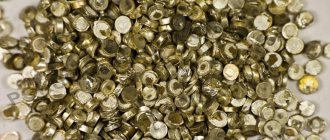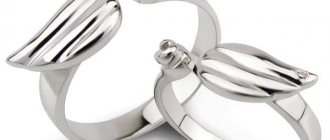Silver items marked with the hallmark of 84 hallmarks of Tsarist Russia can now only be purchased in antique shops. These figures refer to the old spool system, which was used from 1711 until 1927, after which it was replaced by metric. 84-carat silver was usually used to make glass holders, cigarette cases, cutlery, and very rarely jewelry.
Composition and properties
The 84-karat alloy contains 87.5% silver, the rest is copper. The alloy may also contain:
- zinc;
- aluminum;
- nickel;
- cadmium.
Each additive affects the mechanical properties and color of the alloy.
Strength
Due to the copper content, products made from the alloy have high strength characteristics compared to pure silver. The products are not subject to mechanical wear, do not wear out, do not scratch or darken. Copper also gives the alloy a yellow tint.
What types of brands are there?
According to the rules of the assay system of Tsarist Russia, craftsmen had to apply marks to jewelry indicating the fineness of the jewelry metal. The first mark consisted of:
- precious metal sample numbers;
- female profile facing left;
- managers' initials.
To avoid counterfeits, the mark was changed in 1908: the female profile was turned in the opposite direction and letters were added to indicate the area of manufacture. Also in antique products you can find the mark of the master and the year of manufacture.
See photos with various marks:
Conversion from spool to metric system
To find out which modern standard 84 corresponds to, you need to convert the value to the metric system. To convert 84 samples, you need to divide it by 96 and multiply by 1000.
Thus: 84 / 96 * 1000 = 875. In the metric system, 1 kg of 875 silver contains 875 g of pure metal and 125 g of impurities (copper).
Antique value of 84-carat silver
For antique items made of precious metals, the cost of the metal itself is not always the main thing. Much more important is the authenticity of the thing itself and its age. Often, it is the year of appearance that determines the price of a particular specimen.
And the presence of a genuine hallmark of 84 hallmark means that the age of the hallmarked item actually exceeds 100 years, and, most likely, much more. After all, the last time an hallmark with the numbers 84 was placed on silver items was in 1926.
In addition, knowing the details of changes in the constituent elements of this mark, you can determine the time of manufacture of the branded item without contacting specialists. For example, by the presence or absence of a female profile in a kokoshnik or by the direction of this profile.
And additional marks located next to the main one will help to more accurately determine not only the age, but also the manufacturing workshop, and sometimes the name of the craftsman who made the antique item. And such knowledge will make it easier to search for the significance of an item in various catalogs. And, perhaps, it will turn out that this is not just an antique thing, but a genuine rarity of considerable price.
Advantages and disadvantages
In its pure form, silver is a very beautiful metal, but it is soft, so products quickly lose their shine and are easily damaged. Therefore, with the help of additives (ligatures), the strength and wear resistance of products is increased. The peculiarity of this metal is its yellow color, which misleads ordinary citizens.
The 84th or modern 875 standard is considered low, and jewelry is not made from it. Due to the copper content, 84-grade silver is cheaper in price, but the presence of an alloy makes the metal stronger. Dishes made from it can be used in everyday life, washed and cleaned. Silver does not scratch and retains the brightness of the surface.
Where was the alloy with purity 84 used?
Silver items with the hallmark 84 were popular before the revolution among wealthy Russians due to their good price-quality ratio. This alloy retained most of the qualities of pure silver, but was not too soft and was suitable for long-term use. And its price was affordable not to the rich, but simply to wealthy people. Silver with such a quantity of ligature was rarely used to create jewelry. Due to the impurities included in its composition, they oxidized over time and became covered with a dark coating.
The alloy of this sample was most widely used in the manufacture of prestigious items for personal and household use. Silverware, jewelry boxes and cigarette cases are just a partial list of such items. Although inexpensive, they were not accessible to everyone, they served as a kind of indicator of the status of the owner. Their darkening over time was easily eliminated by short cleaning. The resistance of the alloy to influences made it possible to clean objects made of this metal without causing damage to them.
How much does 1 gram of silver of this standard cost today?
The cost of valuable metals fluctuates depending on the situation on the world market. By tracking the daily reports of the Central Bank of Russia, you can find out the current cost. The price at a pawn shop or antique market may vary.
Below is a live graph and table with prices.
| Price 999 standard according to the Central Bank | Market value of the sample today | Scrap price | Price in jewelry |
General information
Sample 84, stamped on silver, served to determine the quality of white metal in Russia until 1927. The numbers indicated that the product contained 84 parts of pure silver and only 12 parts of other impurities.
In the past, almost a dozen samples were used to mark silver. Each product differed in the composition of the alloy, on which its cost depended. The lowest marking indicated that the metal consisted of only half of noble metal. Things were valued according to the principle that the purer the silver composition, the more you would have to pay for it. The stamp with the numbers 84 is now valued quite highly, but the final cost will depend on how old it was minted.
It is interesting that the pre-revolutionary “spool system” existed for another 10 years after the end of the monarchy era in 1917, because no better replacement has been invented to indicate the value of a product.
84 silver hallmark, used until 1908
Recommendations for care, cleaning and storage
Those who are lucky enough to become owners of antique cutlery should follow the rules for caring for them:
- wash with warm soapy water and air dry;
- store wrapped in soft cloth;
- Avoid rooms with high humidity.
If the product has darkened, you can clean it with a mixture of salt and soda. You should mix these two components, apply it to the item and wait until it takes on its original appearance.
Then rinse with water and wipe.
Product care
People who are lucky enough to become owners of antique silver should remember that if the basic rules of care are not followed, the products quickly tarnish, losing their aesthetic appeal. In order for cutlery and jewelry to retain their original appearance for as long as possible, they must be treated with care, keeping in mind the key features of the metal. Caring for silver involves:
- Timely cleansing. After use, dishes and cutlery are carefully washed with warm soapy water, rinsed and left to dry completely. Jewelry is removed and wiped with a soft cloth.
- Proper storage. Silver products do not belong in rooms with high humidity. In addition, to avoid mechanical damage, each item is stored wrapped in paper.
- Avoid prolonged contact with skin. Silver with the hallmark 84 contains quite a lot of copper, which tends to react with sulfur oxide released by the human body along with sweat, so during activities that involve physical effort, jewelry must be removed. It is highly advisable to remove jewelry during hygiene procedures and at night - if you neglect this rule, the jewelry will quickly darken.
Clean silver using soda, salt and ammonia. You can use the products either individually or by mixing them to a homogeneous paste. In addition, toothpaste, egg yolk, hydrogen peroxide and lipstick are often used for cleansing.
However, since any cleaning of precious metal is associated with the possibility of damage (primarily this applies to jewelry with stones and complex patterns), it is best not to risk it and take the product to a jeweler who will perform the procedure professionally.
Antique silver items are of great value and can be an excellent gift for a true collector. But in order not to make a mistake in your choice, you need to know what types of antique silver there are and purchase only rare jewelry that has passed an appraisal examination.
Reviews
Valentine
Thanks for the information, it turns out that antique items should be sold not by the gram, but as a whole. And the better the condition of the item, the greater the amount you can get.
Igor Ivanovich
I have an antique silver spoon from tsarist times, inherited. At first I wanted to sell it, but decided to use it on the farm. I think the food tastes better from it.
Zoya
In our pawnshop they accept silver so cheaply that it would be better worth it at home. I will donate it to museums as an antique, or pass it on to my grandchildren as an inheritance.
general description
Fineness is a proportional ratio of the content of the main noble metal in the alloy. The 84 stamp on silver not only indicates historical value, but also serves as an indicator that there are 84 parts of precious metal for 96 alloy parts of the product.
In Tsarist Russia, the standard was measured not in the now familiar metric system, but in the spool system, that is, built on the basis of the Russian pound, containing 96 spools. Silver jewelry of that time was marked with stamps depicting a woman in a kokoshnik. At the same time, initially the woman’s head was directed to the left, and since 1908 (due to the increasing frequency of counterfeits) - to the right. Nearby were the numbers of the spool assay and the initials of the manager of the assay district. Until 1917, the products also indicated the year of branding, corresponding to the date of issue.
Until the 19th century, a convex relief test was placed on silver, which after 1897 was replaced with a curved one. The size of the mark was determined by the type of item: large marks were stamped on cutlery, and miniature ones on jewelry. By the mark one could easily find out which jewelry house was responsible for the manufacture of a particular product.
The cost of silver depending on the sample
The cost of different silver samples is subject to change annually. You need to choose which silver to buy based on your budget. If finances allow, you need to choose high-quality jewelry.
The main factors that influence the price of silver products:
- metal price rate on the international exchange;
- try;
- product weight;
- trade fair;
- the presence of decorative elements and stones;
- markup in a retail store.
To understand whether the price offered for silver jewelry is adequate, you need to compare its value at a pawnshop. The price of finished jewelry depends on the standard of the silver and how many impurities it contains. The higher the standard, the higher the price of accessories. If we talk about antique things, the amount of pure metal is not always taken into account; the cost of the product is determined by its condition, weight and year of manufacture.
Silver is a noble metal, jewelry made of which looks attractive on the body of women, men and children. But in order for the product to serve you for a long time, you need to choose high-quality, high-quality accessories. The article described which silver samples are suitable for jewelry, dishes or decorative elements.
Silver markings on jewelry
The sample is indicated not only on paper tags that are sold along with jewelry. Marking is also required on the accessories themselves, so that you can see what percentage of metal they contain. The sample number is placed in different places:
- on a clasp or earrings;
- in the inner part;
- closer to the clasp.
If the product is very thin, then the sample is stamped on a small molten plate. On cookware, markings are placed on the back of the handle.
If there is no marking, this is a fake that contains no metal. Most often, unmarked products are made of medical or stainless steel. If your accessory is made in Russia, in addition to the sample number, there will be a small stamp on the jewelry.
Price per gram in Russia for the last month
84 sterling silver is a unique alloy, the cost of which is determined in accordance with several indicators:
- market value of silver;
- year of production of the product;
- its antique and (or) historical value;
- product weight and other characteristics.
We recommend reading: What are diamond carats and how are they valued?
Let's calculate the market value of one gram of 84-carat silver without taking into account the historical, antique value of the products:
What is sterling silver
In ancient times, English coins - sterling - were made from 925 silver. According to another legend, sterling silver was originally minted in Saxony in the Esterling region. This is how it got its name. Silver was used to produce coins that served for trade relations with England. And only after that the pound sterling came into use in Britain. Antique sterling silver was considered incredibly high quality, and is still highly valued for making household items, art, and jewelry.
Determining the authenticity of silver products
The variety of marks on antique objects makes it difficult to determine the sample. If in Great Britain and Germany the hallmark system was legally regulated for centuries, then the creations of Italian jewelers are very difficult to identify, since mandatory marking began to be used in the country only in 1870.
It is possible to determine the authenticity of silver at home. One of the properties of metal is high thermal conductivity, so a piece of ice placed on an object quickly melts. They also check the material by sound - to do this, you need to knock on the dubious product with a silver coin. The purity of the sound will indicate authenticity.
One of the common counterfeiting techniques is transferring the sample to an object using soldering. The joints are masked by blackening or engraving. In this case, only a professional with experience and the necessary equipment can determine the authenticity of the product.
The history of stamps is quite well studied. Signs and places where markings were applied changed over different time periods, so identifying the product does not cause difficulties for specialists. Very Important Lot auction catalogs contain items that have been pre-screened by experts. In the lot cards you will find a detailed description of antique silver products - jewelry, dishes, toiletries and elegant small items.
The use of the royal sample then and now
Nowadays, 84 sterling silver is used to create cutlery, inexpensive jewelry, jewelry boxes, ashtrays, and souvenirs. The material has high strength, so it is used for products subject to constant physical impact.
Antique royal silver was used to create the following items:
Crockery and cutlery
The popularity of silverware peaked between 1840 and 1940, as trade between countries expanded during this period. Tsarist Russia produced a wide variety of silver utensils: spoons, forks, knives, cups, plates, deep dishes, decanters, teapots, coffee pots. Serving the table with precious cutlery was considered a rule of good manners among the nobility.
Antique tableware made of 84 sterling silver
Silver kitchen utensils were valued for their antibacterial properties, status, and lack of toxic effects on the body.
Decor items
The hallmark of 84 sterling silver can be seen on candlesticks, vases, glass holders, and frames. Russian master jewelers indicated their initials on such items, and the work itself was performed using casting and carving techniques.
Vintage collectibles
Such jewelry works include cigarette cases, boxes, and figurines. Crosses, icons, and coins of pre-revolutionary Russia with 84 markings are of great value to collectors.
Accessories
The alloy was used to cast rings, earrings, necklaces, bracelets, rings, and chains. Nowadays such material is almost never used to create jewelry. The most popular modern standard is 925.
Of particular cultural and historical value are items produced by the jewelry companies of Khlebnikov, Sazikov, Ovchinnikov, and Postnikov. These famous workshops appeared in the 17th century. They were distinguished by the production of truly masterpiece products, worthy of nobles and kings.
Catalog of Russian silver samples, hallmarks
We have tried to collect complete information about samples of Russian silver products from the 18th and 19th centuries, by which we can determine the master, the year of production and the city of the sample.
Form for selling antiques
- Antique silver samples of Veliky Ustyug
- Antique silver samples from Vologda;
- Antique silver hallmarks of Nizhny Novgorod;
- Antique silver samples of Kazan;
Antique silver from St. Petersburg, hallmarks
- Hallmarks of Russian silver by Carl Faberge. silver samples;
- Antique silver silver from the Russian jewelry house of the Grachevs Mikhail and Simeon Gavrilovich, hallmarks;
- Russian jewelry master Pavel Fedorovich Sazikov, silver samples;
- Jewelry workshop of Russian silver, master's sample Karl Bolin;
Antique silver from Moscow factories, hallmarks
- Moscow factory of silver products of Ivan Semyonovich Gubkin, hallmarks;
- Russian silver factory of Nikolai Vasilyevich Nemirov-Kolodkin, silver hallmarks;
- Jewelry master of silver products Ovchinnikov Pavel Akimovich, silver samples;
- Masterpieces of silversmith Ivan Petrovich Khlebnikov, hallmark silver;
